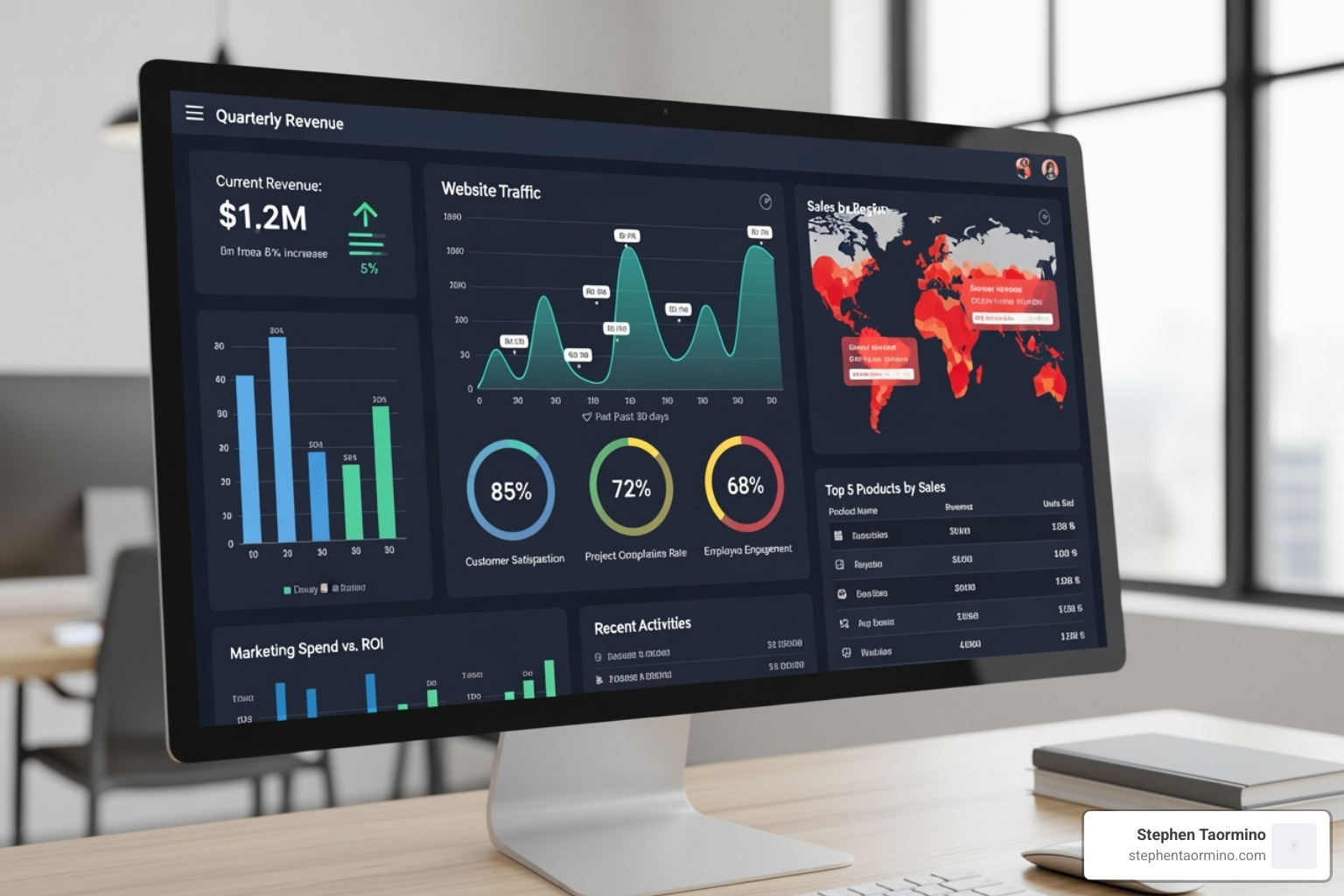Drive Business Results: Unlock 4x Growth Now
Beyond Busywork to Business Breakthroughs
The ability to drive business results isn’t about working harder—it’s about working smarter with a clear focus on what truly moves the needle. While many leaders get caught in a cycle of tasks, the most successful organizations shift their mindset from outputs (what you do) to outcomes (what you achieve). Real growth comes from focusing on customer-centric goals, making data-driven decisions, and building accountability at every level.
The research is clear: organizations that align their people, culture, and strategy don’t just survive—they thrive, experiencing revenue growth rates four times higher than those that don’t. But here’s what most business advice gets wrong: driving results isn’t about choosing between being results-focused or people-focused. The best leaders do both simultaneously, creating environments where high performance and employee engagement fuel each other.
I’m Steve Taormino, and with over 25 years of experience helping organizations build prosperity, I’ve seen how the right strategic approach can drive business results that once seemed impossible. My work as an expert witness and with international CEOs has taught me that sustainable success always comes down to understanding the psychology behind human behavior and decision-making.
The Foundational Shift: Focusing on Outcomes, Not Just Outputs
Many businesses learn too late that being busy isn’t the same as being successful. You can have teams churning out work, but if that activity doesn’t translate into real customer value, you’re just spinning your wheels. The secret to drive business results lies in a fundamental shift from outputs to outcomes.
Think of it this way: a customer doesn’t want a quarter-inch drill bit (the output); they want a quarter-inch hole (the outcome). The drill bit is the tool, but the hole is the solution. This mindset shift is the difference between struggling companies and those that build loyal customer bases and sustainable growth. When you focus on outcomes, you stop asking, “How much can we produce?” and start asking, “What problem are we truly solving for our customers?”
| Feature | Output-Focused Mindset | Outcome-Focused Mindset |
|---|---|---|
| Primary Goal | Maximize quantity, productivity | Achieve meaningful results, customer value |
| Focus | Tasks completed, products produced | Customer goals, desired impact |
| View | Short-term, immediate gains | Long-term, sustainable growth, brand reputation |
| Differentiation | Difficult to stand out | Easier to differentiate, customer-centric design |
This approach leads to stronger customer satisfaction, a better brand reputation, and more sustainable business growth. For companies ready to make this shift, the opportunities for customer-centric strategies are limitless.
What Does ‘Driving Results’ Mean in a Business Context?
To drive business results is to be strategic. It means leaders must master focusing on priorities, cutting through the noise to identify the critical objectives that yield the greatest impact. They create urgency without chaos, instilling a proactive mindset that balances speed with quality. Making informed decisions is another hallmark, which involves gathering necessary information before acting decisively. Perhaps most importantly, result-driven leaders build accountability. They implement tracking mechanisms to ensure progress and follow-through, making the entire organization more effective. Without this, even the best strategies fail. Leaders can learn how to make better decisions using proven frameworks.
Applying the ‘Outcomes vs. Outputs’ Mindset for Growth
Shifting to an outcome-first mindset has immediate, measurable impacts. When you design your customer-centric strategy around what customers want to achieve, everything changes. Instead of just focusing on business outcomes like market share, you prioritize customer outcomes—the specific goals or improvements customers hope to achieve by working with you.
When you design every interaction around delivering these outcomes, you build customer loyalty and create sustainable growth. The numbers back this up: improving CX by just one point can translate to over $1 billion in additional revenue for a large company. This is the power of focusing on customer success. When customers succeed because of you, they become advocates who drive referrals and organic growth. This makes customer outcome-centric strategies the foundation for exponential growth.
The Human Engine: How Leadership and Engagement Fuel Success
Most leadership advice presents a false choice: be results-driven or be employee-focused. But what if this is wrong? Our research, based on data from over 60,000 leaders, reveals that leaders rated in the top quartile of both results-driven and employee engagement skills ranked in the 91st percentile of all leaders. This isn’t about choosing between being tough or kind—it’s about mastering both.

The most successful leaders understand that driving business results requires creating an environment where people feel valued, motivated, and invested in success. Your people are the engine that powers your business. If you’re ready to develop this capability, you can find leadership development expertise.
Essential Leadership Competencies to Drive Business Results
Leaders who consistently drive business results while keeping teams engaged share three critical competencies:
- Accountability: This starts with leaders owning their decisions and maintaining high standards. When leaders model this behavior, team members hold themselves to the same standards, and organizational effectiveness soars.
- Decision-making: The best leaders don’t rush to judgment. They dig deep to understand issues, gather facts, and consult their teams for diverse perspectives. This builds buy-in and shared ownership of the results.
- Asking the right questions: Great leaders go beyond the surface. They ask what I call “future-based questions” or “Afters”—defining what success looks like after a project is complete. This clarifies the ultimate goal and aligns everyone toward the same vision.
These competencies create leaders who don’t just achieve results—they inspire others to achieve more than they thought possible. To develop these capabilities, consider how you can build your high-performing team.
The Powerful Link Between Employee Experience and Performance
Employee experience is a direct driver of bottom-line results. When employees are genuinely engaged—not just satisfied—they are invested in your company’s mission. The data shows that companies solving for engagement move the needle on productivity, revenue, and customer ratings two to three times more effectively.
A crucial element is “Ease of Work”—removing unnecessary friction from employees’ daily tasks. When people can focus on meaningful work instead of battling bureaucracy, their trust, creativity, and productivity increase. This positive experience extends to your customers. Perhaps most importantly, insights-based decisions generate 8X growth compared to business as usual. Your people are your secret weapon for understanding your organization and market. When you act on their feedback, they become even more invested in your success. To strengthen these channels, explore ways to improve your organizational communication.
Strategic People Alignment to Drive Business Results
For HR and organizational leaders, aligning people strategies with business goals is essential. HR’s role has evolved into a strategic partnership critical for organizations that want to consistently drive business results. This means developing and retaining top talent through clear career paths and performance management, fostering a culture of innovation where it’s safe to take calculated risks, and using data to guide strategic decisions. When people strategies directly support business objectives—like rapid expansion or market pivots—the entire organization is positioned for success. For leaders ready to master these alignments, executive leadership training can provide the necessary frameworks and insights.
The Culture Catalyst: Building a Foundation to Drive Business Results
Many leaders see culture as the “fluffy stuff” to worry about after handling “real” business. But after 25 years of working with global organizations, I can tell you that culture is the secret weapon that either accelerates your success or quietly sabotages it. Your strategy is just expensive paper if your people don’t believe in it.

Leaders often feel they must choose between caring for people and hitting numbers. This is wrong. When people feel connected to the mission, they excel, and the business thrives. The numbers are clear: companies that successfully align purpose, strategy, and culture see revenue grow by 44.5% over three years. That’s four times higher than companies that don’t. Real culture isn’t about perks; it’s the beliefs and behaviors that shape how work gets done.
The Culture Equation: Purpose + Strategy, Powered by Culture
I’ve found that exceptional organizations follow what I call “The Culture Equation”:
Organizational Purpose + Strategy, powered by Culture = Results
- Purpose is your “why.” It’s the reason your organization exists beyond making money, inspiring people to contribute to something bigger than themselves.
- Strategy is your “what” and “how.” It’s your roadmap for achieving your goals. But even the best strategy is worthless without the right culture.
- Culture is the “how it feels.” It’s the collective beliefs and behaviors that either amplify or undermine your purpose and strategy. Culture doesn’t just support strategy—it powers it.
Here’s my contrarian take: culture might be more important than strategy. I’ve seen mediocre strategies succeed with exceptional cultures and brilliant strategies fail with poor ones. Organizations that master this equation can drive business results that are five times more profitable. If you’re ready to harness this power, consider how to develop leadership for business growth.
Practical Steps to Build and Scale a Winning Culture
Building a culture that drives business results requires intentional, practical steps woven into your daily operations.
- Operationalize desired behaviors. Get specific about what your culture looks like in action and build those behaviors into performance reviews and recognition.
- Codify your strategy. Make your strategy clear and accessible so everyone understands their role in the bigger picture.
- Establish strategic anchors. These are measurable results that connect directly to your purpose, giving teams clear targets.
- Influence underlying beliefs. Many organizations get stuck in an “action trap,” pushing for activity without addressing the beliefs that drive performance. Use storytelling to show values in action, provide specific and timely feedback, and use strategic recognition to celebrate actions that align with your desired culture.
By focusing on experiences that shape how people think and feel, you can create real, lasting cultural change. For guidance on developing this leadership capability, get help with leadership development consulting.
The Strategic Blueprint: From Data to Decisions and Action
A clear strategy and strong culture are academic without effective execution. This is where you translate vision into tangible action that can drive business results. This blueprint is the bridge between your big-picture vision and the daily decisions that move your organization forward.

In today’s data-rich world, information is our compass. But having data and using it effectively are two different things. The organizations that truly drive business results master this translation process: they turn data into insights, insights into decisions, and decisions into impact. To get started, consider how to leverage a data change strategy.
Leveraging Data for Smarter, Faster Decisions
Data and analytics are essential for making informed decisions that drive business results and keep teams engaged. The real game-changer is your Insights Utilization Rate—how effectively your organization absorbs and applies data-driven insights. This isn’t about fancy dashboards; it’s about creating a culture where insights influence action. The payoff is huge: insights-based decisions generate 8X growth compared to business as usual.
For marketing teams, this means aligning marketing KPIs directly with business objectives like profitable growth. Customer analytics are also critical, allowing for personalized strategies and optimized experiences. By consistently collecting, analyzing, and acting on data, you empower your teams to make smarter, faster decisions. If you’re looking to improve your marketing through better data use, you can increase your digital marketing ROI.
Avoiding Common ‘Action Traps’ and Pitfalls
Even with solid data, organizations can fall into “action traps” that hinder their ability to drive business results. The most common is a relentless focus on doing more without addressing the underlying beliefs that drive behavior. It’s like bailing out a leaky boat without patching the hole.
To escape this trap, you must focus on beliefs, not just actions. As discussed, experiences shape beliefs, so craft them intentionally through storytelling and feedback. Ruthless prioritization is also key. Avoid initiative overload by focusing on what’s most important to achieving strategic goals. Finally, ensure stakeholder alignment to prevent misunderstandings from derailing projects. By stepping back from the urge to just “do something,” you can create more sustainable change. To refine your approach, consider how you can master your sales strategy.
Measuring What Matters: Key Indicators of Success
To know if you’re succeeding, you must measure the right things. This goes beyond simple financials to show how well your culture, strategy, and people are aligned.
- Financial Outcomes: Revenue growth, profitability, and ROI are the hard numbers. Aligned companies see significantly higher growth (44.5% over three years) and 5X profitability.
- Customer Engagement Metrics: Look beyond satisfaction to metrics like customer lifetime value and Net Promoter Score (NPS). Only 29% of B2B customers are fully engaged, highlighting a massive opportunity.
- Employee & Experience Metrics: Track engagement scores, retention rates, and “Ease of Work.” High-performing teams, driven by engaged employees, directly contribute to business outcomes.
- Strategic & Innovation Metrics: Measure if employees understand the strategy and how quickly your organization can adapt and innovate.
Focusing on these comprehensive indicators gives you a holistic view of performance, allowing you to make data-driven adjustments. Understanding these metrics is vital for optimizing your investments—explore marketing ROI best practices to learn more.
Conclusion: Your Path to Peak Performance Starts Now
The journey to drive business results is an ongoing process that weaves together leadership, culture, and strategy. Like a conductor leading an orchestra, you must bring all the elements together to create the symphony your organization is capable of performing.
We’ve explored how the most successful organizations shift from counting outputs to celebrating outcomes. They stop asking “How much did we do?” and start asking “What meaningful impact did we create?” The human element is where the magic happens. The best leaders don’t choose between being results-focused or people-focused—they master both simultaneously. They create environments of ownership and collaboration.
Culture is the invisible force that amplifies your strategy. When purpose, strategy, and culture align, organizations flourish, seeing revenue growth four times higher than those that don’t. But knowing these principles isn’t enough. The key to applying them is understanding the psychology behind human behavior. People don’t just follow strategies—they follow stories and pursue purposes that resonate with them.
At Stephen Taormino, we’ve spent over 25 years helping organizations open up this potential. My work has shown me that sustainable success always comes down to understanding how people think, connect, and act. Our approach is to dive deep into the unique psychology of your organization and market, crafting strategies that make both logical and emotional sense.
The path forward starts with a simple recognition: your people are your greatest asset, but only if you know how to open up their potential. This means building confidence, fostering meaningful relationships, and developing leaders who inspire. It’s about creating systems that support both high performance and deep engagement.
Ready to transform how your organization thinks, connects, and acts? Let us help you open up your team’s potential with behavioral economics marketing techniques. Because when you understand the psychology behind performance, everything becomes possible.
